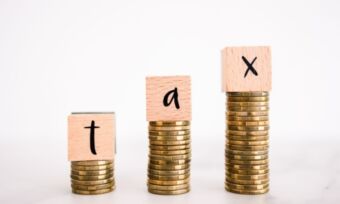How to lodge a tax return in Australia

The average Australian tax return can bring a healthy cash boost to your bank balance after you’ve paid the ATO, or you might get a hefty, unwanted bill. KPMG’s Global Mobility Tax Advisory Services Partner, Ursula Lepporoli, explains the basics of tax returns, sharing 3 steps to lodgement.
After the close of the financial year on 30 June, individuals are required to check in with the Australian Taxation Office (ATO). This process is called a tax return and has evolved over time, from collecting a paper TaxPack from the Post Office to a digital experience that has developed over the last decade.
What is a tax return?
The tax return is an annual reconciliation process. The ATO asks you to report your income and deductions, along with any tax withheld, so it can issue an assessment confirming your calculations are correct, including the application of Australia’s income tax rates. Doing your tax return can help ensure you get a refund if you’ve paid too much tax during the year. Alternatively, it can help you work out if you owe any extra tax to the ATO.
A person can receive a coveted tax refund if their deductions exceed their income and/or there has been too much tax withheld from their take-home pay. The most typical source of withholding is through employers, who are required to regularly remit taxes to the ATO based on tables and calculators on the ATO’s website. Financial institutions are also required to withhold tax from some payments they make to customers – such as interest on savings accounts – in certain situations. Franking credits on regular cash dividends paid out of a company’s profits to the owners of the business (i.e., the shareholders) are also refundable.
Some taxpayers, particularly those who earn money from investments or a business, may choose or be required to pay instalments of tax throughout the year based on their prior year’s income, adjusted for inflation. These are known as pay-as-you-go (PAYG) instalments. The tax return process allows for these instalment amounts to be reconciled to what tax the person actually owed for the year, to ensure they pay the right amount of tax overall.
You could say that the building blocks of your tax return start with completing your Tax File Number (TFN) declaration or providing your TFN to someone who pays you income (such as an employer or bank), as this helps them work out how much tax they should withhold from your pay, which is then checked for accuracy through the tax return process.
Every person must lodge their own tax return and there is no joint filing with a spouse or domestic partner in Australia. That said, you may need to include some details of your spouse or domestic partner’s income in your tax return, depending on your circumstances. You can speak to a tax professional if you need help with lodging your tax return.
Do I need to do a tax return?
Generally speaking, once an individual has met any of the following criteria, they are responsible for determining if they have to lodge an Australian tax return:
- they have obtained a TFN
- they have worked in or for the benefit of Australia
- they have received Australian-sourced investment income that is not subject to withholding.
Once you’ve met one of these criteria, you must either lodge a tax return or advise the ATO one is not required through a non-lodgment advice form every financial year. You should seek professional tax advice if you are unsure whether you should lodge a return.
Are there reasons I might not need to lodge a tax return?
There are a few reasons why the ATO may no longer require someone to lodge a tax return, such as if the person has indicated a return is a ‘final’ tax return (e.g. if they are leaving Australia permanently without holding any taxable Australian property), or if they’ve died and had a ‘date of death tax return’ lodged on their behalf. At the time of writing, the ATO also advises that if you receive Australian Government payments as your only source of income and tax was not withheld from them, you may not need to lodge a tax return, provided your income is below certain thresholds.
In essence, though, once you start having to lodge tax returns, you can’t stop while you are alive until you advise the ATO that you are not required to lodge one.
Do I need to lodge a tax return if I live outside Australia?
Even individuals living outside of Australia may be required to lodge a tax return. This occurs in many circumstances, including but not limited to if they earn:
- rental income and deductions
- investment income not subject to withholding tax at source, such as interest, dividends or trust income (there are tax agreements and treaties that may impact the tax treatment of trust income)
- any income in another country, to determine repayment of their HELP debt
How do I do a tax return? 3 steps
There are 3 steps to follow to do a tax return:
- Choose the process you want to follow
- Gather your income and deductions
- Submit
1. Choose the process you want to follow
Decide if your affairs are complex and whether a tax agent might be the best solution. The ATO says that in addition to lodging with a registered tax agent, you can consider lodging your return online with myTax, or lodging a paper return.
Should I consider using a tax agent?
If any of the following circumstances apply to you, a tax agent could provide advice and help ensure your tax affairs are properly managed.
- Complex tax residency. If your travel patterns have been impacted by the pandemic or you normally spend a significant period of time away from your usual place of residence each year, your tax residency may not be straightforward. Tax residency determines how much, if any, of your income is taxable and/or reportable in Australia, and may be different to your residency status for immigration purposes.
- Major transactions (such as selling a property). The legislation to determine the cost base and sale price of an asset can be difficult to understand for many people, and getting it right could potentially make thousands of dollars of difference in tax. The interaction of rules regarding residency and the main residence exemption can easily make selling a property challenging for the average taxpayer.
Wider reasons you may also consider a tax agent include if you might need help with:
- family trusts
- are self-employed or running a business
- have foreign income or tax paid
- are a temporary visitor to Australia without access to a Medicare card.
The Tax Practitioners Board (TPB) is a national body responsible for the registration and regulation of tax agents. If you’re comparing tax agents, look for the TPB’s symbol to confirm you are using an approved practitioner, or search for one using the TPB website.
2. Gather your income and deductions
It’s best to start gathering your income and deductions as soon as 1 July by using the ATO’s myDeductions app or a similar tool. Tracking your expenses throughout the year will help you remember everything, so you can provide the details directly to the ATO or to your tax agent when it’s time to start your return.
3. Submit
Provide your collected information to your tax agent, or start your return through myTax. The myTax experience is user-friendly for a taxpayer who doesn’t have complex tax matters to worry about, like those noted.
You will require a myGov account and may also set up a myGovID in the setup. Both require details from documents to prove your identity. myTax is pre-populated with information that employers and financial institutions are required to report directly to the ATO, including your income and tax withheld throughout the financial year.
It even has details of your private health insurance for consideration when assessing your liability for the Medicare Levy Surcharge and the Private Health Insurance Rebate. It is important to note that to benefit from the pre-population, you should wait until late July to prepare your tax return.
How do I lodge a tax return?
You can lodge a tax return electronically, either through your tax agent or in the myTax app. It is possible to lodge a return via paper form; however, this process can take significantly longer. The ATO generally prefers to deliver refunds electronically and will only make payments into Australian bank accounts.
How long does a tax return take?
The ATO says it aims to process electronically lodged tax returns within two weeks. When a Notice of Assessment (NOA) has not been issued within 28 days, tax agents are able to escalate with the ATO to resolve the matter.
What tax return deadlines apply?
Tax returns for individuals without a tax agent are due on 31 October following the 30 June end of the financial year. Tax agents can provide their clients in good standing with the ATO (i.e. those who have no outstanding tax returns) with extensions beyond 31 October.
- 15 May following the 30 June year end is the latest extension widely available for taxpayers
- 31 March is the concessional due date for those with prior year tax liabilities greater than $20,000.
The tax agent extensions also include additional time to pay. Tax payments are typically due 21 days after the due date of the tax return or the issue date of the Notice of Assessment (NOA), based on whichever is earliest, with prior year tax liability the amount that was due on the NOA for the prior year.
→ Related: Visit Canstar’s Tax Hub
Cover image source: Watchara Ritjan/Shutterstock.com
 About Ursula Lepporoli
About Ursula Lepporoli
Ursula Lepporoli is KPMG’s Global Mobility Tax Advisory Services Lead in Melbourne. Ursula began her career in tax in 2005 and has amassed a deep expertise in all matters pertaining to the taxation of the remuneration of local and globally mobile employees, including, but not limited to, individual income tax (AUS & US), Fringe Benefits Tax, Payroll Tax and Employee Share Scheme reporting. She most enjoys providing practical advice to her clients.
This article was reviewed by our Sub Editor Jacqueline Belesky before it was updated, as part of our fact-checking process.







